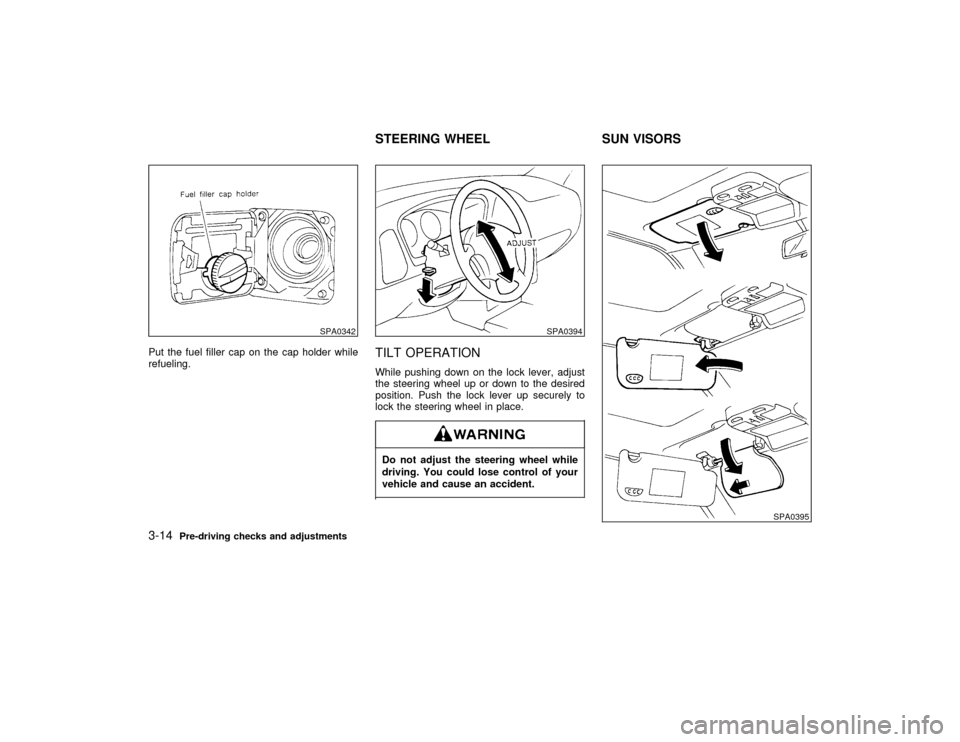fuel NISSAN PATHFINDER 1999 R50 / 2.G Owners Manual
[x] Cancel search | Manufacturer: NISSAN, Model Year: 1999, Model line: PATHFINDER, Model: NISSAN PATHFINDER 1999 R50 / 2.GPages: 274, PDF Size: 2.34 MB
Page 3 of 274

Welcome To The World Of NISSANYour new NISSAN is the result of our dedication
to produce the finest in safe, reliable and eco-
nomical transportation. Your vehicle is the prod-
uct of a successful worldwide company that
manufactures cars and trucks in over 17 coun-
tries and distributes them in 170 nations.
NISSAN vehicles are designed and manufac-
tured by Nissan Motor Co., Ltd. which was
founded in Tokyo, Japan in 1933, and NISSAN
affiliates world wide, collectively growing to be-
come the fifth largest automaker in the world. In
addition to cars and trucks, NISSAN also makes
textile machinery, fork-lift trucks, marine engines,
boats and other products.
NISSAN has made a substantial and growing
investment in North America, starting with the
opening of Nissan Motor Corporation U.S.A. in
1960 and continuing with the production of some
cars and trucks at one of the world's mostmodern manufacturing facilities, Nissan Motor
Manufacturing Corporation U.S.A. in Smyrna,
Tennessee, vehicle styling at Nissan Design
International in San Diego, California, and engi-
neering at Nissan Research and Development in
Farmington Hills, Michigan.
NISSAN and its dealers indirectly employ about
60,000 Americans.
NISSAN is also a substantial contributor to the
Canadian economy. Nissan Canada Inc., its sup-
pliers and over 150 dealers employ approxi-
mately 4,500 people. These include company
employees and the staffs of NISSAN dealers all
across Canada. In addition, many Canadians
work for companies that supply NISSAN and
NISSAN dealers with materials and services
ranging from operation of port facilities and trans-
portation services to the supply of lubricants,
parts and accessories.NISSAN pioneered the use of electronics and
computers in automobiles, and has led the indus-
try in improving both performance and fuel effi-
ciency through new engine designs and the use
of synthetic materials to reduce vehicle weight.
The company has also developed ways to build
quality into its vehicles at each stage of the
production process, both through extensive use
of automation and Ð most importantly Ð
through an awareness thatpeopleare the cen-
tral element in quality control.
From the time the parts arrived from our suppli-
ers until you took delivery of your new Nissan,
dozens of checks were made to ensure that only
the best job was being done in producing and
delivering your vehicle. NISSAN also takes great
care to ensure that when you take your NISSAN
to your dealer for maintenance, the service tech-
nician will perform his work according to the
quality standards that have been established by
the factory.
Safety has also been built into your NISSAN. As
you know, seat belts are an integral part of the
safety systems that will help protect you and your
passengers in the event of a sudden stop or an
accident. We urge you to use the seat belts every
time you drive the vehicle.
The NISSAN story of growth and achievement
reflects our major goal: to provide you, our
customer, with a vehicle that is built with quality
and craftsmanship Ð a product that we can be
proud to build and you can be proud to own.
AFW0001Z
01.1.22/R50-D/V5
X
Page 53 of 274

2 Instruments and controlsInstrument panel ....................................................... 2-2
Meters and gauges ................................................... 2-3
Speedometer and odometer ..................................... 2-3
Tachometer ............................................................... 2-4
Engine coolant temperature gauge ........................... 2-4
Fuel gauge ................................................................ 2-5
Compass and outside temperature display (if so
equipped) .................................................................. 2-6
Outside temperature display ..................................... 2-6
Compass display ....................................................... 2-7
Warning/indicator lights and chimes ......................... 2-9
Checking bulbs.......................................................... 2-9
Warning lights ........................................................... 2-9
Indicator lights ......................................................... 2-12
Chimes .................................................................... 2-14
Security system ....................................................... 2-14
Theft warning (if so equipped) ................................ 2-14
Nissan vehicle immobiliser system ......................... 2-16
Windshield wiper and washer switch ...................... 2-16
Rear window wiper and washer switch................... 2-17
Glass hatch and outside mirror (if so equipped)
defogger switch ...................................................... 2-18
Headlight and turn signal switch ............................. 2-18
Headlight switch ...................................................... 2-18Daytime running light system (Canada only) .......... 2-20
Turn signal switch ................................................... 2-21
Front fog light switch (if so equipped)..................... 2-22
Hazard warning flasher switch ................................ 2-22
Horn......................................................................... 2-23
Heated seats (if so equipped) ................................. 2-23
Power socket........................................................... 2-24
Cigarette lighter and ashtray ................................... 2-25
Storage .................................................................... 2-25
Glasses case........................................................... 2-26
Cup holders ............................................................. 2-26
Glove box ................................................................ 2-27
Console box ............................................................ 2-28
Luggage hooks........................................................ 2-30
Cargo net (if so equipped) ...................................... 2-31
Tonneau cover (if so equipped) .............................. 2-31
Luggage rack (if so equipped) ................................ 2-32
Windows .................................................................. 2-33
Power windows (if so equipped) ............................. 2-33
Sunroof (if so equipped) ......................................... 2-34
Automatic sunroof ................................................... 2-34
Interior lights............................................................ 2-35
Personal lights......................................................... 2-36
Vanity mirror light (if so equipped) .......................... 2-37
Z
01.1.22/R50-D/V5
X
Page 58 of 274

the engine is overheated, continued op-
eration of the vehicle may seriously
damage the engine. See ªIf your vehicle
overheatsº in the ª6. In case of emer-
gencyº section for immediate action
required.
FUEL GAUGEThe gauge indicates the APPROXIMATE fuel
level in the tank.
The gauge may move slightly during braking,
turning, acceleration, or going up or down hill.
The gauge needle is designed to remain in
approximately the same position, even when
the ignition key is turned OFF.
Refill the fuel tank before the gauge regis-
ters Empty.
The indicator light comes on when the fuel
tank is getting low. Refuel as soon as it isconvenient, preferably before the gauge
reaches E. There will be a small reserve of
fuel in the tank when the fuel gauge needle
reaches E.
If the vehicle is driven with the fuel level
very low, the malfunction indicator light
may come on. Refuel as soon as pos-
sible. After re-fueling, the light should
go off. If the light remains on, have the
vehicle inspected by an authorized
NISSAN dealer.
For additional information, see the ªMal-
function indicator light (MIL)º later in
this section.
SIC0960
Instruments and controls
2-5
Z
01.1.22/R50-D/V5
X
Page 65 of 274

Automatic transmission oil
temperature warning light
(
model)
This light comes on when the automatic trans-
mission oil temperature is too high. If the light
comes on while driving, reduce the vehicle
speed as soon as safely possible until the light
turns off.Continued vehicle operation when the
A/T oil temperature warning light is on
may damage the automatic trans-
mission.
Tire carrier open warning light
(if so equipped)
This light comes on when the tire carrier is not
closed securely while the ignition key is ON.INDICATOR LIGHTS
Overdrive off indicator light
(Automatic transmission
models only)
This light comes on during driving when theoverdrive switch is pressed to prevent over-
drive operation.
The O/D OFF indicator light comes on for two
seconds each time the ignition key is turned
ON. This shows the light is functioning prop-
erly.
If the O/D OFF indicator light blinks for
approximately 8 seconds after coming on for
2 seconds, have your NISSAN dealer check
the transmission and repair it if necessary.The automatic transmission is equipped with
an electronic Fail-Safe mode. This system
allows the vehicle to be driven even in the
event of damage to the electrical circuits. If this
occurs, the gears automatically engage and
lock into 3rd gear.
See ªDriving the vehicleº in the ª5. Starting
and drivingº section for failsafe before vis-
iting your NISSAN dealer.
Turn signal/hazard indicator
lights
The light flashes when the turn signal switch
lever or hazard switch is turned on.
High beam indicator light
This light comes on when the headlight highbeam is on, and goes out when the low beams
are selected.
Cruise indicator light (if so
equipped)
The light comes on while the vehicle speed is
controlled by the cruise control system.
If the light flickers while the engine is running,
it may indicate there is something wrong with
the cruise control system. Have the system
checked by your NISSAN dealer.
Malfunction indicator light
(MIL)
If the Malfunction indicator light comes on
steady or blinks while the engine is running, it
may indicate a potential emission control prob-
lem.
The malfunction indicator light may also come
on steady or blink if the fuel filler cap has not
been closed tightly or if the fuel tank is nearly
empty. Check to make sure the fuel cap is
secure and that you have at least 3 US gallons
(14 liters) of fuel in the fuel tank.
After driving for a while, the light should remain
off if no other potential emission control sys-
tem problem exists.
2-12
Instruments and controls
Z
01.1.22/R50-D/V5
X
Page 66 of 274

Operation
The Malfunction indicator light will come on in
one of two ways:
IMalfunction indicator light on steady Ð An
emission control system malfunction has
been detected. Have the vehicle inspected
by an authorized NISSAN dealer. You do
not need to have your vehicle towed to the
dealer.
IMalfunction indicator light blinking Ð An
engine misfire has been detected which
may damage the emission control system.
To reduce or avoid emission control system
damage:
* do not drive at speeds above 45 MPH (72
km/h).
* avoid hard acceleration or deceleration.
* avoid steep uphill grades.
* if possible, reduce the amount of cargo
being hauled or towed.
The malfunction indicator light may stop blink-
ing and come on steady.
Have the vehicle inspected by an authorized
NISSAN dealer. You do not need to have your
vehicle towed to the dealer.
Continued vehicle operation without
having the emission control system
checked and repaired as necessary
could lead to poor driveability, reduced
fuel economy, and possible damage to
the emission control system.
4WD indicator light
This light comes on when the transfer shift
control lever is in the 4H or 4L position.
Nissan Communicator redial
indicator light (if so equipped)
After turning the ignition key to the ON posi-
tion, the redial indicator light will illuminate for
up to 30 seconds and then turn off.
This indicator light comes on when the initial
connection is not successful. The Nissan
Communicator is attempting to redial to con-
tact the Communicator Response Center. The
redial indicator may blink before the button
indicator blinks. See ªNissan Communicatorº
later in this section.
Nissan Communicator no
service indicator light (if so
equipped)
After turning the ignition key to the ON posi-
tion, the no service indicator light will illuminate
for up to 30 seconds and then turn off.
This indicator light comes on when the cellular
phone is outside of cellular phone transmis-
sion range. The Nissan Communicator will not
be able to contact the Communicator Re-
sponse Center. See ªNissan Communicatorº
later in this section.
Nissan Communicator
ªMaydayº emergency button
indicator light (if so equipped)
After turning the ignition key to the ON posi-
tion, the ªMaydayº emergency button indicator
light will illuminate for up to 30 seconds and
then turn off if the system is operational.
This button indicator light comes on when the
ªMaydayº emergency button is pressed. When
the light is blinking, Nissan Communicator is
trying to acquire an available cellular channel.
When the light is ON, the system is connected
to a cell and is communicating information to
the Communicator Response Center. See
ªNissan Communicatorº later in this section.
Instruments and controls
2-13
Z
01.1.22/R50-D/V5
X
Page 102 of 274

Cellular airwave interferenceAt times you may hear someone other than the
Communicator Response Center operator
talking. This is caused by cellular airwave
interference and is not caused by an Nissan
Communicator system malfunction. Generally,
if you are driving, the interference will go away.
If cellular airwave interference occurs when
the Nissan Communicator system is transmit-
ting data to the Communicator Response Cen-
ter, the Nissan Communicator system auto-
matically switches to voice communications.
There may be cases where cellular airwave
interference may prevent the Nissan Commu-
nicator System from completing the connec-
tion to the Communicator Response Center.SecurityThe Nissan Communicator system uses the
cellular phone network. Conversations and
data transmissions are not secure. Third par-
ties may be able to listen to your conversation.Aftermarket accessoriesWhen installing a CB radio or car phone in
your NISSAN, be sure to observe the following
cautions. Otherwise, the new equipment may
adversely affect the Multiport Fuel Injection
system, Nissan Communicator system, or
other electronic parts.
Potentially inoperative if the vehicle
is in an accidentIf you are involved in an accident, Nissan
Communicator may also be damaged. Since
Nissan Communicator is powered from the
vehicle, damaged Nissan Communicator re-
lated components such as the battery will
disable the system.Inoperative if cellular phone is
inactive or inoperativeNissan Communicator will be inoperative if you
do not have an active cellular account with a
cellular provider. Since Nissan Communicator
relies on the cellular network, the system will
not work if the cellular service or your cellular
phone is inactive.
When the Nissan Communicator system is
outside of cellular service, the
indicator
will illuminate. If you try to activate Nissan
Communicator, the request will be canceled.
Cellular phone transmission may become tem-
porarily disabled, or interrupted by environ-
mental factors such as tunnels, bridges, or tall
buildings. When Nissan Communicator en-
counters such a situation, the system attempts
to dial for up to two hours. This time varies
greatly depending on the cellular network and
cellular signal strength. The system resets toready when the system completes the dialing
attempts. You can press the button again if
you still need to contact the Communicator
Response Center. After several failed at-
tempts the system will quit dialing and return to
normal mode.
Phone number changesThe Nissan Communicator system is only ca-
pable of accepting up to 15 phone number
changes. You may need to purchase Nissan
Communicator system components if the
phone number changes more than 15 times.IKeep antennas as far away as pos-
sible from electronic control units (in-
cluding radio and Nissan Communi-
cator system components).
IKeep antenna wire more than 8 in (20
cm) away from the Multiport Fuel In-
jection and Nissan Communicator
harnesses. Do not route antenna
wires next to any other harness.
Instruments and controls
2-49
Z
01.1.22/R50-D/V5
X
Page 106 of 274

3 Pre-driving checks and adjustmentsKeys .......................................................................... 3-2
Doors ......................................................................... 3-2
Locking with key ........................................................ 3-3
Locking with inside lock knob ................................... 3-3
Locking with power door lock switch (if so
equipped) .................................................................. 3-4
Child safety rear door lock ........................................ 3-4
Multi-remote control system (if so equipped)............ 3-5
How to use multi-remote control system .................. 3-5
Hood .......................................................................... 3-9
Back door ................................................................ 3-10
Key operation .......................................................... 3-10
Spare tire carrier (if so equipped) ........................... 3-11Glass hatch ............................................................. 3-11
Key operation .......................................................... 3-11
Fuel filler lid ............................................................. 3-12
Opener operation .................................................... 3-12
Fuel filler cap ........................................................... 3-13
Steering wheel ........................................................ 3-14
Tilt operation ........................................................... 3-14
Sun visors ............................................................... 3-14
Using the sun visors ............................................... 3-15
Mirrors ..................................................................... 3-15
Inside mirror ............................................................ 3-15
Outside mirrors ........................................................ 3-15
Z
01.1.22/R50-D/V5
X
Page 117 of 274

Other key operationsITurning the key clockwise locks all doors
including the back door.
ITurning the key counterclockwise unlocks
the back door.
ITurning the key counterclockwise again
unlock all doors.Do not drive with the glass hatch open.
This could allow dangerous exhaust
gases to be drawn into the vehicle. SeeªPrecautions when starting and drivingº
in the ª5. Starting and drivingº section
for exhaust gas.
Do not open the glass hatch unless the
wiper is in the stowed position.
OPENER OPERATIONTo open the fuel filler lid, push the opener lever
down. To lock, close the fuel filler lid securely.
SPA0956
SPA0389
FUEL FILLER LID
3-12
Pre-driving checks and adjustments
Z
01.1.22/R50-D/V5
X
Page 118 of 274

FUEL FILLER CAPThe fuel filler cap is a screw-on ratcheting
type. Tighten the cap clockwise until ratcheting
clicks are heard.IGasoline is extremely flammable and
highly explosive under certain condi-
tions. You could be burned or seri-
ously injured if it is misused or mis-
handled. Always stop the engine and
do not smoke or allow open flames orsparks near the vehicle when refuel-
ing.
IFuel may be under pressure. Turn the
cap one-half turn, and wait for any
hissing sound to stop to prevent fuel
from spraying out and possible per-
sonal injury. Then remove the cap.
IDo not attempt to top off the fuel tank
after the fuel pump nozzle shuts off
automatically. Continued refueling
may cause fuel over-flow, resulting in
fuel spray and possibly a fire.
IUse only a genuine NISSAN fuel filler
cap as a replacement. It has a built-in
safety valve needed for proper opera-
tion of the fuel system and emission
control system. An incorrect cap can
result in a serious malfunction and
possible injury.
INever pour fuel into the throttle body
to attempt to start your vehicle.
IIf fuel is spilled on the vehicle body,
flush it away with water to avoid paint
damage.
ITighten until cap clicks, failure to
tighten fuel cap properly may cause
the
malfunction indicator light
(MIL) to illuminate. If this occurs, se-
curely close the fuel filler cap. After
driven for a while, the light should
remain off. If the light remains on,
have the vehicle inspected by an au-
thorized NISSAN dealer.
For additional information, see the
ªMalfunction indicator light (MIL)º in
the ª2. Instruments and controlsº
section.
SPA0341
Pre-driving checks and adjustments
3-13
Z
01.1.22/R50-D/V5
X
Page 119 of 274

Put the fuel filler cap on the cap holder while
refueling.
TILT OPERATIONWhile pushing down on the lock lever, adjust
the steering wheel up or down to the desired
position. Push the lock lever up securely to
lock the steering wheel in place.Do not adjust the steering wheel while
driving. You could lose control of your
vehicle and cause an accident.
SPA0342
SPA0394
SPA0395
STEERING WHEEL SUN VISORS
3-14
Pre-driving checks and adjustments
Z
01.1.22/R50-D/V5
X